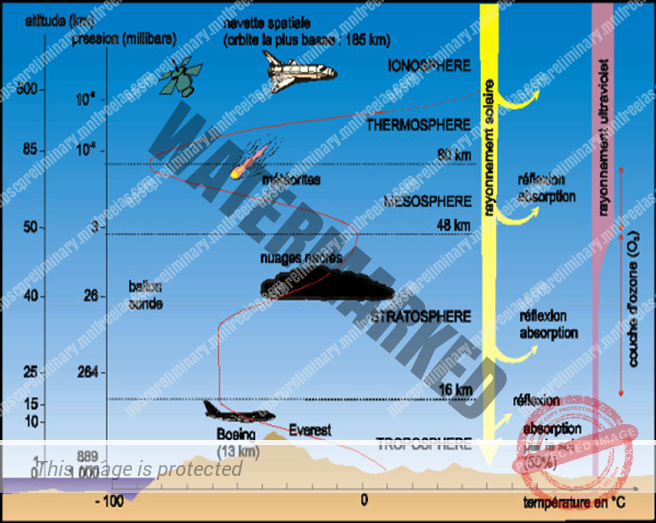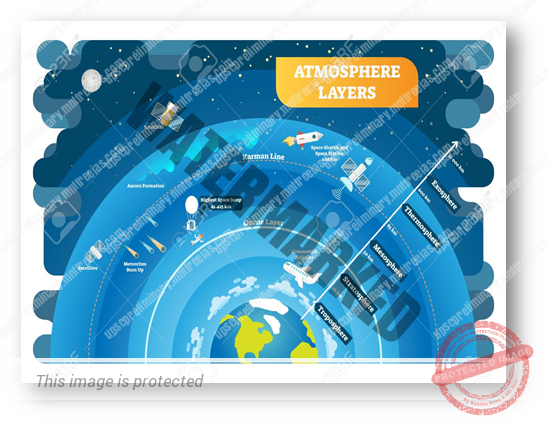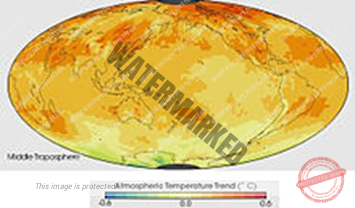- STRUCTURE OF THE ATMOSPHERE
- TROPOSPHERE
- TEMPERATURE
UNIT 4 – CLIMATOLOGY – PART 2
STRUCTURE OF THE ATMOSPHERE
The atmosphere consists of different layers with varying density and temperature. Density is highest near the surface of the earth and decreases with increasing altitude.
Our atmosphere is divided into five layers starting from the earth’s surface. These are Troposphere, Stratosphere, Mesosphere, Thermosphere and Exosphere.
TROPOSPHERE
The word troposphere is derived from the Greek tropos (meaning “turn, turn toward, change”) and sphere (as in the Earth), reflecting the fact that rotational turbulent mixing plays an important role in the troposphere’s structure and behavior. Most of the phenomena associated with day-to-day weather occur in the troposphere
The troposphere is the lowest layer of atmosphere of the Earth and the layers to which changes can greatly influence the floral and faunal environments. Atmosphere of the Earth: it extends from Earth’s surface to an average height of approximately 12 km although this altitude actually varies from approximately 30,000 ft at the polar regions to 56,000 ft) at the equator, with some variation due to weather. The troposphere is bounded above by the tropopause, a boundary marked in most places by a temperature inversion (i.e., a layer of relatively warm air above a colder one), and in others by a zone which is isothermal with height.
Although variations do occur, the temperature usually declines with increasing altitude in the troposphere because the troposphere is mostly heated through energy transfer from the surface. Thus, the lowest part of the troposphere (i.e., Earth’s surface) is typically the warmest section of the troposphere, which promotes vertical mixing. The troposphere contains approximately 80% of the mass of the atmosphere of the Earth.
The troposphere is denser than all its overlying atmospheric layers because a larger atmospheric weight sits on top of the troposphere and causes it to be most severely compressed. Fifty percent of the total mass of the atmosphere is located in the lower 18,000 ft of the troposphere.
Nearly all atmospheric water vapor or moisture is found in the troposphere, so it is the layer where most of Earth’s weather takes place. It has basically all the weather-associated cloud genus types generated by active wind circulation although very tall cumulonimbus thunder clouds can penetrate the tropopause from below and rise into the lower part of the stratosphere. Most conventional aviation activity takes place in the troposphere, and it is the only layer that can be accessed by propeller-driven aircraft.
This layer is the most important layer of the atmosphere. Its average height is 13 km. The air we breathe exists here. Almost all the weather phenomena like rainfall, fog and hailstorm occur in this layer.
The temperature in this layer decreases at the rate of 1°C for every 165m of height. This is the most important layer for all biological activity
The zone separating the troposphere from stratosphere is known as the tropopause.
In addition, the atmosphere is generally described in terms of layers characterized by specific vertical temperature gradients. The troposphere is characterized by a decrease of the mean temperature with increasing altitude. This layer, which contains approximately 85–90% (v/v) of the atmospheric mass, is often dynamically unstable with rapid vertical exchanges of energy and mass being associated with convective activity.
Globally, the time constant for vertical exchanges is of the order of several weeks. Much of the variability observed in the atmosphere occurs within this layer, including the weather patterns associated, for example, with the passage of fronts or the formation of thunderstorms.
The planetary boundary layer is the region of the troposphere where surface effects are important, and the depth is on the order of 3300 ft but varies significantly with the time of day and with meteorological conditions. The exchange of chemical compounds between the surface and the free troposphere is directly dependent on the stability of the boundary layer.
TEMPERATURE
This image shows the temperature trend in the Middle Troposphere as measured by a series of satellite-based instruments between January 1979 and December 2005. The middle troposphere is centered around 5 kilometers above the surface. Oranges and yellows dominate the troposphere image, indicating that the air nearest the Earth’s surface warmed during the period. “Source”.
The temperature of the troposphere generally decreases as altitude increases. The rate at which the temperature decreases, {\displaystyle -dT/dz} is called the environmental lapse rate (ELR). The ELR is nothing more than the difference in temperature between the surface and the tropopause divided by the height. The ELR assumes that the air is perfectly still, i.e. that there is no mixing of the layers of air from vertical convection, nor winds that would create turbulence and hence mixing of the layers of air.
The reason for this temperature difference is that the ground absorbs most of the sun’s energy, which then heats the lower levels of the atmosphere with which it is in contact. Meanwhile, the radiation of heat at the top of the atmosphere results in the cooling of that part of the atmosphere.



